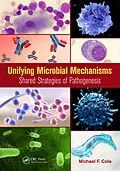Microbial pathogenesis is the study of the mechanisms by which microbes (bacteria, viruses, protozoa, and multicellular parasites) cause infectious disease and make their hosts (humans) ill. Bacterial infections we thought were easily treatable are again a huge cause for concern with the well-publicized rise of antibiotic resistance. There are very few effective antiviral drugs and we live with the threat of epidemics such as bird flu and the outbreaks of viruses such the recent (and ongoing) Ebola crisis. Parasitic diseases such as malaria continue to pose a heavy burden in the developing world and with climate change could spread into the developed world. There is therefore an urgent need to understand microbial mechanisms, with research programmes and university courses dedicated to the subject.
Autorentext
Mike Cole is an experienced instructor at Georgetown University where he is professor of microbiology and immunology and teaches microbial pathogenesis, immunology, and bacteriology. His research interests are into the regulation of commensal and pathogenic bacteria at the mucosal surface by the secretory immune response and the ontogeny of the secretory immune system. He regularly attends the ASM education conference and is the author of half the bacterial cases in Case Studies in Infectious Disease.
Inhalt
Contents
Preface xv
Acknowledgement xvii
Chapter 1: Introduction to Pathogenesis 1
Introduction
Henle-Koch postulates and evolving
views of infectious disease causation
Experimental models of pathogenicity
The ethics of using humans, animals and cell lines in
pathogenics research 6
Advantages and disadvantages of human experimentation
in the study of the pathogenesis of infectious diseases 8
Animal models in the study of the pathogenesis of
infectious diseases 8
Other considerations in experimental models of the
pathogenesis of infectious diseases 10
Human cell lines as a surrogate for microbe-host interactions 12
Bibliography
Chapter 2: Normal Microbiotas of the Human Body 17
Introduction
Microbiota of the skin 20
Microbiota of the vagina 22
Microbiota of the urinary tract 25
Microbiota of the conjunctiva 31
Respiratory tract microbiota 31
Microbiota of the alimentary canal
Mouth 34
Oesophagus 40
Stomach 40
Small intestine 40
Large intestine 44
Key concepts
Bibliography
Chapter 3: Biofilms 59
Introduction
Biofilms structure and properties
Mucosae versus skin 60
Initial steps in biofilm formation 61
Biofilm development and the climax community 63
Quorum sensing in biofilms 65
Biofilm dispersal 67
Biofilms in human infections
Peripheral and central i.v. catheters 67
Urinary catheters 68
Bladder biofilms 69
Endotracheal tubes 69
Peritoneal cavity dialysis catheters 70
Prosthetic joints 71
Heart valves 71
Chronic wounds 71
Otitis media 73
Cystic fibrosis 74
Biofilm formation by filamentous fungi
Biofilm formation by viruses
How biofilms are studied
Key concepts
Bibliography
Chapter 4: Adhesion to Host Surfaces 87
Introduction
Barrier epithelia
Skin 88
Mucous membranes (mucosae) 89
Blood and lymphatic vessels 91
Blood-brain barrier 92
Foeto-placental interface 93
The extracellular matrix and intercellular adhesion molecules
Abiotic surfaces 94
Initial adhesion events 95
Adhesin-receptor interactions
Protein-carbohydrate (lectin) interactions 97
Bacteria 98
Fungi 102
Viruses 103
Parasites 106
Protein-protein interactions
Microbial surface components recognising adhesive matrix
molecules 107
Fibrinogen-binding MSCRAMMs 115
Vitronectin-binding MSCRAMMs 116
Proteoglycan-binding adhesives 117
Bacteria 117
Viruses 117
Parasites 118
Anchorless adhesins (Moonlighting proteins) 119
Bacteria 119
Fungi 120
Protozoa and multicellular parasites 120
Cell wall glycopolymers 121
Capsules 121
Galectins as bridging molecules in microbial adhesions
Adhesion to other barriers
Endothelium of blood vessels and lymphatics 124
Key concepts
References
Chapter 5: Facilitated Cell Entry 129
Introduction
Crossing intact skin
Enzymatic degradation 131
Crossing intact mucosal epithelium
Entry via microfold (M) cells 132
Enzymatic degradation 133
Polar tube formation 134
Moving junction 134
Paracytosis 135
Endocytosis 138
Reorganisation of the actin cytoskeleton and endosomal
trafficking 141
Exploitation of endocytosis pathways by pathogens
Bacteria 145
Zipper mechanism
Trigger mechanism 148
Viruses 156
Fungi 156
Microtubule reorganisation
Transcytosis
Key concepts
Bibliography
Chapter 6: Exotoxins and Endotoxins 167
Bacterial exotoxins
Introduction 167
Membrane-acting toxins 168
Superantigens (SAs) 168
Heat-stable exotoxins (STs) 170
Membrane-damaging exotoxins
a-helical pore-forming exotoxins 172
ß-barrel pore-forming exotoxins 173
RTX exotoxins 175
MARTX exotoxins 176
Intracellular exotoxins
AB exotoxins 177
AB5 exotoxins 179
AB exotoxins 182
Fungal toxins
Parasite exotoxins
Endotoxins
Key concepts
Bibliography
Chapter 7: Extracellular Degradative Enzymes 187
Introduction
Proteases
Potential roles of microbial proteases in pathogenesis
Tissue destruction and cell internalisation 188
Inactivation of plasma protease inhibitors 189
Activation of bradykinin-generating and blood-clotting
cascades 190
Protease-activated receptor 190
Chemoattractant molecules 191
Immunoglobulins 191
Microbe and parasite glycosidases
Deglycosylation of immunoglobulins 194
Adhesion 194
Microbe and parasite phospholipases
Bacterial phospholipases 196
Fungal phospholipases 198
Parasite phospholipases 198
Key concepts
Bibliography
Chapter 8: Evasion of the Human Innate Immune System 201
Introduction
Antimicrobial peptides
Overview 201
Bacterial evasion of AMPSs 204
Fungal evasion of AMPs 205
Virus evasion of AMPs 205
Parasite evasion of AMPs 205
The complement system
Recruiting and mimicking RCAs 210
Destroying complement components 213
Microbial envelope/wall components that inhibit
complement 214
Evasion resulting from cell wall structure 214
Consuming complement in the fluid phase 214
Circumvention of phagocytosis
Chemoattraction 216
Regulation of chemokines 218
Circumventing pattern recognition receptors
Subversion of PRR crosstalk 223
Targeting cytosolic PRRs, IPS-1, RIG-I and MDA5 224
Masking microbe-associated molecular patterns 225
Manipulating host inhibitory signaling
Pathogen survival inside host cells
Bacteria 228
Arresting the phagosome/endosome 229
Diverting the endosomal/phagoso…
